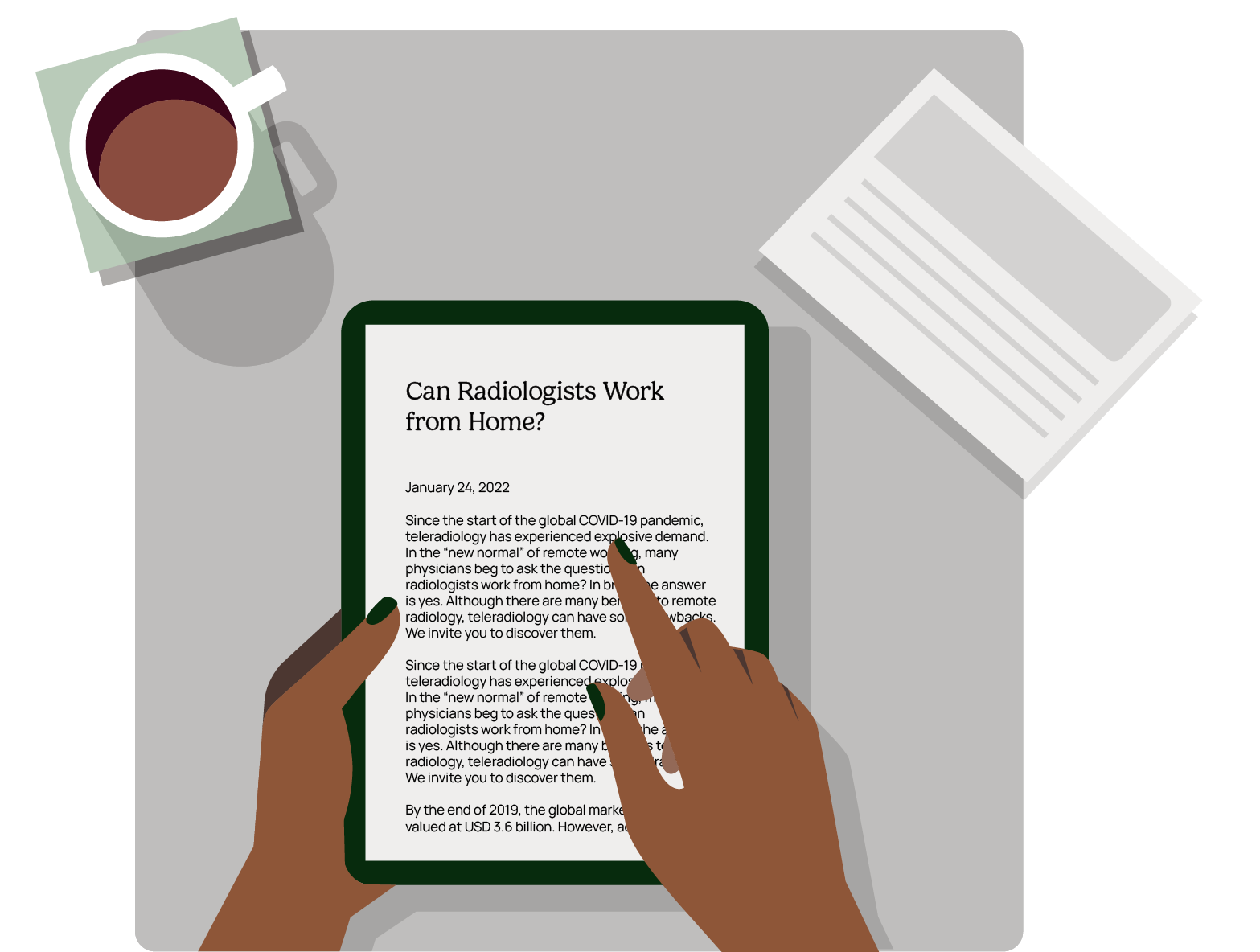January 24, 2022
Since the start of the global COVID-19 pandemic, teleradiology has experienced explosive demand. In the “new normal” of remote working, many physicians beg to ask the question can radiologists work from home? In brief, the answer is yes. Although there are many benefits to remote radiology, teleradiology can have some drawbacks. We invite you to discover them.
Since the start of the global COVID-19 pandemic, teleradiology has experienced explosive demand. In the “new normal” of remote working, many physicians beg to ask the question can radiologists work from home? In brief, the answer is yes. Although there are many benefits to remote radiology, teleradiology can have some drawbacks. We invite you to discover them.
By the end of 2019, the global market size was valued at USD 3.6 billion. However, according to a report by Grand View Research, “the global teleradiology market size is estimated to reach USD 10.9 billion by 2027, registering a CAGR of 13.9% over the forecast period.” The report also found that X-rays, Ultrasound, Magnetic Resonance Imaging (MRI), Computed Tomography (CT), and Nuclear Imaging were the leading diagnostic imaging services requested. As North American countries continue to lead the demand for diagnostic imaging, we are also seeing a rise in the Asia Pacific region due to supportive regulations from their governments.
The study stated that the lack of radiologists, paired with the rising demand for imaging procedures, is expected to make the market bullish. Furthermore, the global pandemic demonstrated a wake-up call to the industry. As medical facilities placed safety and reduction in the spread of Covid-19 as paramount, radiologists were allowed to work remotely, oft from their homes with the proper technology setup, in an effort to reduce staff.
In a case study in clinical practice management, physicians Mohammed Imran Quraishi, MD, Robert E Heidel, Ph.D., and Avez A Rizvi, MD, stated an ideal resolution “The COVID-19 pandemic has brought new challenges that are obligating radiology practices to take a second look at off-site reading as a potential way to decrease radiologist exposure to severe acute respiratory syndrome coronavirus 2 (SARS-CoV-2).”
Teleradiologists working from home and using technology to facilitate virtual meetings have become an industry standard for many radiologists. What once was considered an ‘overnight service only’ is now a viable career option for those physicians who don’t desire to work in the hospital or imaging center environments. These physicians gain from the perspective of more productivity, independence, and better work-life balance. However, many of the same advantages of radiologists working from home can couple as disadvantages. Let’s delve into them.
Pros & Cons of Radiologists Working from Home
Pros
Productivity
Avoiding burnout is one of the top concerns among radiologists. According to a research report, diagnostic radiologists experience some of the highest burnout rates among all physicians. The study found that “burnout can result in unprofessional behavior, thoughts of suicide, premature retirement, and errors in patient care.”
Therefore, radiologists working from home can alleviate some of these stress markers;
- As there is no stress of commuting to work.
- They are isolated from other staff, fostering more focus.
- They work in a different environment than a medical or imaging center and in the comfort of their home office.
Flexibility
Teleradiologists often experience more flexibility than those reporting to medical or imaging centers. Whereas, many can elect their schedules- a luxury uncommon in physical centers pre-COVID. This is made possible because the physician has a home PACS (Picture Archiving and Communication System) workstation.
Better Work-Life Balance
Radiologists who work from home experience more balance in their home and work lives in comparison to colleagues who do not. This is because they have more flexibility for personal and social activities. This can result in less work-related stress and happier professionals.
Subspecialization
In most cases, radiologists are expected to be generalists in practice. However, radiologists working from home have more control over subspecialty with teleradiology. “Though you might be expected to be knowledgeable in all areas, there are opportunities to subspecialize,” explains Michael Yuz, MD, MBA, an executive radiologist with USARAD. “You also have the opportunity to stop in and read for hospital radiologists who don’t have the experience in your area of expertise,” Dr. Yuz concludes.
Choice
Many teleradiologists have pointed out that they have the flexibility to choose their radiology partners- whether small or large facilities (depending on personal preference.)
Cons
It is noted that some of the same benefits can be drawbacks in teleradiology. Healthy moderation is vital, here are some disadvantages:
Burnout
As mentioned, burnout is experienced higher among diagnostic radiologists. In addition, several studies have linked radiologists to clinical depression with several key contributing factors, including unexpected high workload, working in low ambient lighting environments, and isolation.
Isolation
Before the introduction of PACS systems, diagnosing radiologists would read at medical or imaging facilities and physically meet with attending physicians working cases. This led to the radiologist’s enhanced understanding of the clinical problem and how imaging results led to more meaningful reports. This is especially important because it enhances their critical role on the health care team, which in turn makes them feel like they belong.
However, radiologists’ work and evaluation have become more isolated from the rest of the medical teams’ work, allowing them to focus solely on their reads for various patients. This isolation has only become more of a prevalent concern with the ability of radiologists to access PACS and viewing systems while working from home.
Subspecialization
Not all subspecialties are deemed suitable for reading from home. For example, interventional radiology or pediatric radiology often have hands-on procedures and benefit more from in-person readings. This may create some inequalities between the various practices.
Regardless of their level of comfort with potential exposure to COVID-19 or preference for working from home, radiologists with more hands-on subspecialties may not be able to.
Work Mixing With Life
When we discuss work-life balance, the focus is not on an infusion of the two, but a blended balance of separating the two.
In any vertical that works remotely, it can be a challenge to separate work and home all of the time. Oftentimes, professionals can experience a blur between the lines of both worlds. Whether it be distractions, frequent communique, or meetings outside of work hours (due to WFH flexibility), it can obscure the barriers between work and personal time.
Radiologists who work from home do not necessarily work fewer hours. In fact, they tend to work more than if they work in a medical or imaging center. According to Dr. Yuz, teleradiologists can find themselves working twice as many hours from home, factoring in 12 to 14 hours shifts.
Hybrid Teleradiology
To solve the problem of isolation among radiology technicians, adopting a hybrid schedule of working in-facility and from home is a viable option to explore. In a recent survey conducted by PWC, remote work has been an “overwhelming success for both employees and employers.”
However, few executives think company culture will survive a purely remote working setup. Based on the survey results, both employees and employers agree working remotely part-time could be ideal for company culture once pandemic concerns recede.
AI in Radiology on the Horizon
With artificial intelligence (AI) in radiology discussions on the rise, many practitioners wrestle with its accuracy and whether it can be a threat to job security. Many verticals have grappled with this question; however, at the outset, AI is meant to enhance the practitioner’s capabilities rather than replace them.
There are a few use cases where the technology has been deployed. For example, Bibb Allen, MD, FACR, CMO of the ACR’s Data Science Institute (DSI), notes, “AI-lite is already being used in radiology in a number of ways, such as computer-aided detection for cancer, auto-segmentation of organs in 3D postprocessing, natural language processing to facilitate critical results reporting, consultation of best guidelines for recommendations, and quantification and kinetics in postprocessing.”
AI is great for alleviating tedious or repetitive tasks, pointing out anomalies, remaining immune to distractions, processing massive amounts of data in a short amount of time, and assisting technicians in making better-informed decisions. According to a study by the American College of Radiology, artificial intelligence in radiology has gone from non-existent to 30% clinical adoption from 2015 to 2020. Adoption forecasts will continue to trend upward, and the industry will have to make adjustments to embrace it in some form or another.
In Summary
Radiologists can work from home. Teleradiology benefits include increased productivity, more flexibility, better work-life balance, plus choice in a subspecialization. However, it is highly recommended that radiologists who solely work from home seek balance with in-facility time and time working from home to reduce the risk of burnout and higher workloads associated with isolation.
Are you thinking of leveraging work from home solutions for radiologists in your organization? Our zero-footprint viewers, InteleViewer and Precession from HeartIT may be right for your team. Request a demo today to learn more about these tools.





